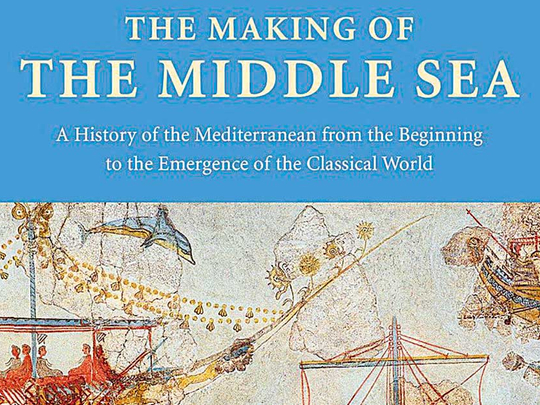
The Making of the Middle Sea
By Cyprian Broodbank, Oxford University Press, 672 pages, $49.95
When Cyprian Broodbank promises in the subtitle to this award-winning book that he will start “from the Beginning”, he should be taken at his word. Indeed, it is not until page 65, by which time we have reached the Miocene period (22 to 5 million years ago), that something vaguely recognisable as the Mediterranean actually makes an appearance, although not all of its geographical features were in their proper place: “Crete , for example, broke off from Turkey some 9 million years ago, carrying with it horses, deer and crocodiles, then disintegrated and foundered, before arising again, looking more like its modern self some 2-3 million years ago.”
At this point, the Mediterranean functioned more as a barrier than a meeting point. It allowed the separate development of Neanderthals on the northern shore and Homo sapiens on the south.
Broodbank is anxious to correct the impression of Neanderthals as ice-age specialists; he insists that they were cold-enduring, not cold-loving, creatures, and they enjoyed some prime Mediterranean real estate in caves at the foot of Gibraltar, along the coast of Croatia and on the Costa del Sol. They were soon mostly outbred, outeaten or indeed eaten by our ancestors.
These new, more modern, hominins painted pictures of what they could see around them on the walls of caves and engaged in obscure but complicated burial symbolism: an elderly disabled woman, identified as a priestess, was discovered in 2008 in a cave in Galilee surrounded by the shells of 50 tortoises consumed in a funerary meal, part of the wing of a golden eagle, a leopard’s pelvis, skulls of pine martens, the tail of a primitive cow and a human foot, not her own.
Having conquered its fringes, these moderns gradually became knowledgeable enough about currents and canoes to colonise the islands of the Mediterranean’s interior, although it wasn’t until about 2000BC that they reached Mallorca, soon putting an end to its fat dwarf sheep, Myotragus balearicus, and giant dormouse, Hypnomys morpheus.
By the time of the last Hypnomys, the eastern Mediterranean was already into the bronze age, and even bronzo-sceptic Egypt was under its 11th dynasty. Broodbank describes the spectacular nature of its civilisations and their remains: the Palace of Minos at Cnossus, the city discovered on Santorini under the rubble of the Thera volcano, the gold of Mycenae, the romance of Troy, the great stash of letters and accounts from Ugarit on the coast of Syria, the Uluburun shipwreck and the “urban giant of Tell el-Dab’a, now rising from the Delta’s mud to challenge us as in its heyday it did the kings of the Nile”.
The book closes in the middle of the first millennium BC as the more familiar world dominated by Greeks and Romans begins to emerge. To cover such a large geographical area over such a long span is an almighty achievement, and the book is also generously illustrated, so that few pages are without maps, diagrams or artists’ reconstructions, my favourite being a rather too imaginative painting of a giant flightless swan taking on a dwarf elephant on Malta. But what probably tipped the balance with the judges when they awarded the book the Wolfson prize for history earlier last year is the fact that all of this information comes in wonderfully elegant prose.
A parenthesis notes that the highest population densities on the coast of the Mediterranean today in Gaza and Monaco reflect freak conditions, “one tragic, the other ludic”.
Another observes that the Baltic is often called “the Mediterranean of the North,’ a compliment that is, tellingly, never reversed”. Almost every paragraph contains memorable metaphors or choice words. No amount of wit and irony, however, will make what used to be called prehistoric archaeology a page-turner.
The problem is in part a reflection of the nature of the facts that need to be told, the numerous find-sites and found objects and the difficulty for a careful archaeologist of jumping to conclusions about what they might mean: “What went on there is unknown, but around it pottery and figurines cluster thickly.”
But the problem is also the result of deliberate and even ideological choices the author has made. This will be a “barbarian” history, he announces, which means he will give equal consideration to what was happening in Croatia and Iberia as to Egypt and Crete.
Even during the pomp and circumstance of the bronze age, he is relieved to be able to praise the work of “a handful of archaeologists admirably indifferent to the blandishments of the palatial south”, so that we turn from the bull-leapers of Crete and the rich archives of the merchants of Ugarit to some hitherto obscure mountain villages of northern Greece: “Analysis of their seeds identified few weeds, indicative of crops still carefully tended in small plots rather than plough-farmed open fields ...”.
He is equally determined to resist any grand narratives centring on the ascent of Mediterranean man or the north-westward spread of civilisation from the fertile crescent. Instead we embark on a series of circuits around the Mediterranean, a snapshot of what’s going on at any one time and how things have changed since the last time we visited.
It is perhaps surprising that another part of the manifesto (and the subtitle) insist this is “history” not “pre-history”. Any kind of narrative of geo-political events — which is one expectation of what the term “history” would evoke — is carefully eschewed in favour of the stories told by artefacts as interpreted by “processual archaeology”.
Thus the end of the bronze age is not presaged by rootless marauding Sea Peoples, as the propaganda of Egyptian pharaohs would have us believe, but by the appearance in the archaeological record of sub-luxury goods, such as coloured glass vessels; it was these “subversive” objects that somehow undermined the palace-cultures of Cnossus and Mycenae and produced what used to be known as the dark ages.
As for the extraordinary spreading out of the Greeks in the first millennium BC to found cities such as Marseille, Cyrene and Naples — what used to be called Greek colonisation — Broodbank has this to say: “At the rather arbitrary point in this continuum of mobility at which people migrated between sub-basins and over old cultural boundaries on a detectable scale, the result has become known as a ‘colony’.”
In fact, as is clear from those examples, Broodbank is not so much transforming prehistory into history as prehistoricising the historical period, reversing the telescope so that broader, vaguer, older patterns emerge that are invisible when examined in too much close-up detail.
He gets this idea from Fernand Braudel, the greatest historian of the Mediterranean. But one function of fudging the difference between history and pre-history — the very longue duree — is to view any particular present reality as deeply rooted and inevitable, the consequence of great natural truths embedded in climate and geography.
Braudel was criticised by Perry Anderson for precisely this use of pre-history for mythmaking in “The Identity of France”. And at times, Broodbank comes across as a kind of Mediterranean nationalist. In many ways, this is one of those books in which it is not so much the substance of what is said about the topic that is important as the fact that a big substantial volume on the topic can exist, a thunderingly affirmative answer, in other words, toan implicit question “Does the prehistoric Mediterranean exist?”
I am not completely sure the author finally convinced me of that. With its megaliths and ubiquitous beaker culture, the western Mediterranean often seems to have more to do with north-western Europe than the Levant, and how useful is it to separate the Nile delta from those parts of pharaonic Egypt further from the sea? In other words, even though this magnificent book runs to nearly 700 pages, it is nevertheless not a textbook but a pamphlet: fascinating, intelligent and well written but also provocative and challenging.
Guardian News & Media Ltd









